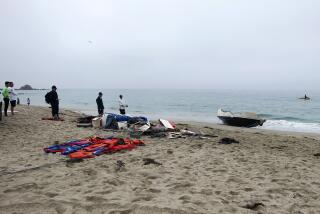Trash Island : Environment: Kayakers take satisfaction--and umbrage--as they clean up Anacapa’s beaches.
- Share via
While most kayakers would be infuriated if they found one of Anacapa Island’s beaches covered with empty plastic oil containers, popcorn-size pieces of Styrofoam, tennis balls and other kinds of trash, Tom Williams was ecstatic.
“I got all excited,” Williams admitted as he tried to balance two bulging sacks of tar-soaked buoys across his kayak. “All I could think was that all this garbage was mine.”
Williams and 11 other scavenging kayakers are participating this week in a three-day cleanup of the beaches on the northern shore of the island. The cleanup, which ends today, is being co-sponsored by the National Park Service and the National Marine Sanctuary Program.
They plucked enough trash from the beaches to fill several large dumpsters; salvaged a 500-pound rope, a wooden ladder and a 10-horsepower outboard motor, and did it all while exploring a part of the Channel Islands National Park that most visitors never see.
It was the second time in three years that kayakers have collected the litter that washes up on Anacapa’s rocky shores.
“People throw all this stuff off of boats in the channel,” said Anacapa Island ranger Mark Senning as he gestured toward a mound of garbage piled on a 15-foot rowboat. Senning is the only ranger stationed on the island.
Plastic containers make up the bulk of the litter collected, Senning said, although spent helium balloons released from the mainland also wash up on Anacapa in high numbers. Because such items float and do not decompose, “they end up on the beaches here after storms,” Senning said.
The diverse group of kayakers--ranging from a 29-year-old Navy diver based in Port Hueneme to a 48-year-old Carpinteria dentist to a 72-year-old retiree from Torrance--often had to cross thick kelp beds before being carried by waves into the small, rocky coves where much of the garbage was found.
They hopped out of their kayaks just as the bottoms of the slender, plastic crafts scraped on the rocks, scurrying to pull the boats onto the shore.
“Once you start looking hard you seem to see more and more trash,” said Rob Widiner, a machinist from Santa Barbara on his first trip to the national park. Widiner paddled a 14-foot, neon green kayak and, like many of the other kayakers, wore a wet suit.
All of the trash--sorted into bags of recyclable plastics, recyclable metals, and non-recyclable or tar-covered materials--was loaded onto the National Park Service cutter Xantu, the designated trash delivery boat Thursday.
John Conti, the dentist from Carpinteria, said a hairbrush and a discarded cervical cap were among the unusual things he found, adding that his beachcombing turned up mostly pieces of Styrofoam cups and remnants of lobster traps.
Conti, who regularly volunteers for other National Park Service cleanup programs, said, “Anacapa is part of a fairly fragile ecosystem, and if it’s abused it won’t be the same.”
Oscar Romo, a 62-year-old retired electrical engineer from Torrance, and Jim Mann, the Navy diver, each found something akin to a message in a bottle--a film canister with a Van Nuys address inside.
Mann said it is distressing that people deliberately throw trash into the ocean. “I’m going to write the guy a letter and tell him not to throw garbage into the ocean,” Mann said.
“If there’s any message in this cleanup, it’s to tell people to recycle the plastic containers on their boats and don’t use the ocean as a dump,” Senning agreed.
Beth Fulson, a ranger aboard the Xantu, said tossing litter into the ocean is a misdemeanor punishable by a $100 fine. Fulson said she has seen lots of debris floating directly behind boats during her daily patrols over the past two years. But she said she never has caught a boater in the act of littering.
“I’ve questioned a lot of them, but I’ve just never been able to prove they did it,” she said.
More to Read
Sign up for Essential California
The most important California stories and recommendations in your inbox every morning.
You may occasionally receive promotional content from the Los Angeles Times.













